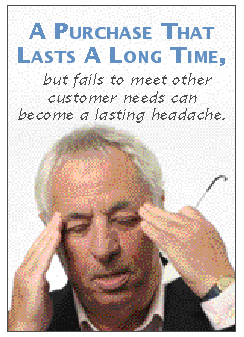The wrong approach to take with customers who ask this question is to start raining a shower of features and benefits on them.
Several years ago I coined a phrase – the valence factors, that account for every one of the benefits any of our customers may end up needing. The word “need” as used here also covers its synonyms such as: want, like, desire, looking for, gotta have, etc. It was with this in mind that the Xerox Company put together Professional Selling Skills, currently owned in its latest version by Achieve Global, an international training and educational company that specializes in a variety of business seminars.
Prominent among the valence factors is the factor of durability. Customers express this “gotta have” variously:
- How long will this last?
- Sure, but will these chairs hold up when I get them home?
- I don’t want any of those cheap veneers.
- The last one I bought didn’t hold up. (Customers’ returning to the store that sold them something that didn’t hold up have always amazed me. Perhaps such customers are looking for a “break” for something that broke.
The wrong approach with such customers is to start out raining a shower of features and benefits on them. Until a salesperson has a clear understanding of the circumstances surrounding a particular need, in this case for a durable product, starting out with a feature/benefit approach will almost always end up being the proverbial barking up the wrong tree.

Salespeople have to win their bragging rights before they can successfully support their customer’s needs. Unless they do so, they end up looking as foolish as the guy who asked the clerk at a sport store, “What’s the best kind of fishing line you have?” No clerk can effectively answer that question until he knows what kind of fish the customer is after and in what kind of water.
Too many salespeople skip trying to find out the circumstances that brought the customer to them in the first place. Others, perhaps there are even more of these, don’t probe further into the circumstances the customers began to explain. Unless salespeople invite customers to elaborate on these circumstances, and to do so without sounding like an investigator, salespeople will fall into the “ditch” awaiting all blind leaders of the blind.
When I’ve asked some salespeople why they skip the probing, they often reply that they want to cut through the mustard or cut to the chase. Regardless of how salespeople phrase it, they all mean the same thing: They want to get to the close as quickly as they can. The irony lies in that the fastest way to get to a successful close is to find out the circumstances surrounding the customer’s needs.
Doing justice to the matter of probing calls for a much longer article than this one. But since we are on the subject of durability, let me make one suggestion regarding how to handle those customers looking for a product that lasts. Salespeople should first make the following reflection on the matter of durability.
Durability is not necessarily a good thing. Ask those who suffer from migraines. What I am getting at is that a durable piece of furniture that does not meet the rest of your customer’s needs (valence factors) can turn out to be a lasting migraine. A customer who buys an expensive, and durable recliner that doesn’t meet their needs for style or comfort, for example, will be reluctant to simply junk it. The longer it lasts, the longer he or she keeps it. The longer he or she keeps it, the longer the pain of a poor purchase.
Once you understand this, you can use the following answer with this kind of customer. “I certainly understand why you want this recliner to last, but I imagine you’re thinking of a recliner that is going to give you lasting comfort. How about telling me the kind of recliner you have in mind. Perhaps you can tell what you really have to have in your next recliner or what you really don’t want to have. Would that be all right?” And when the customer does find the one he or she really likes and is sitting in it, that’s the time to turn to the customer and say something like the following: “Looks like you’ve found one that meets your needs and will last a really long time.”
Don’t run the risk of selling lasting migraines.
Trainer, educator and group leader Dr. Peter A. Marino writes extensively on sales training techniques and their furniture retailing applications. He has deep experience as a top salesman, sales manager, corporate trainer and consultant. Dr. Marino has undergraduate degrees in English and philosophy and a Ph. D. in ancient Greek and Latin. His books include “The Golden Rules of Selling Bedding”, “Stop Losing Those Bedding Sales” and “It’s Buying, Silly!” available through FURNITURE WORLD. Questions can be sent to Peter Marino at pmarino@furninfo.com.
You can read all of Dr. Marino’s articles on furninfo.com in the Sales Skill article archive.